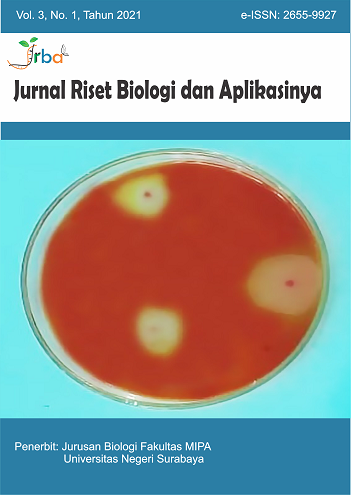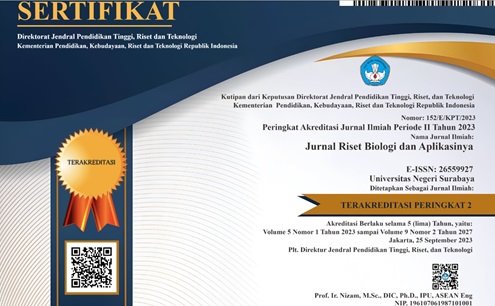The First Investigation of Microplastics Contamination in Estuarine Located in Puger District, Jember Regency, Indonesia
DOI:
https://doi.org/10.26740/jrba.v3n1.p7-12Keywords:
microplastics, pollution, characterization, contamination, estuarineAbstract
Microplastics are harmful to the ecosystem and need to solve immediately. Detection of microplastic contamination is the first step to reduce plastics pollution. Estuarine in Puger has a high potential for microplastic pollution related to the multifunction of waters as ports, tourism, fish market, fish processing, and human settlements. However, there are no studies related to microplastic contamination in the area. The objectives of this research were to determine microplastic contamination in the estuarine located in Puger District, Jember Regency, Indonesia. The research results were the first evidence to inform the society and local government about the actual condition of plastic pollution, especially in the aquatic ecosystem. The sampling sites were determined by purposive sampling. Fifty liters of water from each station (with three repetitions) were taken using a 24V water pump and then filtered using stainless steel filter (mesh 5 mm and 0.2 mm). The filtered samples were placed in a sterile bottle sample, stored at 4 ± 20C. Microplastics were counted and categorized according to size, color, and type under a microscope stereo. Microplastic abundance was calculated based on the number of microplastic particles identified per liter of sample water (particle/liter). The result showed that the study area was contaminated by microplastics throughout site sampling, with abundances varying from 0.03 particles/liter to 0.19 particles/liter. The highest microplastic abundance found near the fishery market. The microplastics also vary in size, color, and type. According to characterization, the sources of microplastic contamination come from human-based activities.
References
Afdal, M., Werorilangi, S., Faizal, A., & Tahir, A. (2019). Studies on Microplastics Morphology Characteristics in the Coastal Water of Makassar City, South Sulawesi, Indonesia. International Journal of Environment, Agriculture and Biotechnology, 4(4), 10281033. https://doi.org/10.22161/ijeab.4421.
Ayuningtyas, W. C. (2019). Kelimpahan Mikroplastik Pada Perairan Di Banyuurip, Gresik, Jawa Timur. JFMR-Journal of Fisheries and Marine Research, 3(1), 4145. https://doi.org/10.21776/ub.jfmr.2019.003.01.5.
Bauer-civiello, A., Critchell, K., Hoogenboom, M., & Hamann, M. (2019). Input of plastic debris in an urban tropical river system. Marine Pollution Bulletin, 144(February), 235242. https://doi.org/10.1016/j.marpolbul.2019.04.070.
Brennecke, D., Ferreira, E. C., Costa, T. M. M., Appel, D., da Gama, B. A. P., & Lenz, M. (2015). Ingested microplastics (>100?m) are translocated to organs of the tropical fiddler crab Uca rapax. Marine Pollution Bulletin, 96(12), 491495. https://doi.org/10.1016/j.marpolbul.2015.05.001.
Clark, J. R., Cole, M., Lindeque, P. K., Fileman, E., Blackford, J., Lewis, C., Lenton, T. M., & Galloway, T. S. (2016). Marine microplastic debris: a targeted plan for understanding and quantifying interactions with marine life. Frontiers in Ecology and the Environment, 14(6), 317324. https://doi.org/10.1002/fee.1297.
Cordova, M. R., & Hernawan, U. E. (2018). Microplastics in Sumba waters, East Nusa Tenggara. IOP Conference Series: Earth and Environmental Science, 162(1). https://doi.org/10.1088/1755-1315/162/1/012023.
Cordova, Muhammad Reza, Purwiyanto, A. I. S., & Suteja, Y. (2019). Abundance and characteristics of microplastics in the northern coastal waters of Surabaya, Indonesia. Marine Pollution Bulletin, 142(March), 183188. https://doi.org/10.1016/j.marpolbul.2019.03.040.
Foekema, E. M., Gruijter, C. De, Mergia, M. T., Franeker, J. A. Van, Murk, A. J., & Koelmans, A. A. (2013). Foekema EM. Plastic in North Sea Fish. ES&T 2013. Environmenrtal Science & Technology, 47, 88188824.
Franzellitti, S., Canesi, L., Auguste, M., Wathsala, R. H. G. R., & Fabbri, E. (2019). Microplastic exposure and effects in aquatic organisms: A physiological perspective. Environmental Toxicology and Pharmacology, 68(March), 3751. https://doi.org/10.1016/j.etap.2019.03.009.
GESAMP Joint Group of Experts on the Scientific Aspects of Marine Environmental Protection. (2016). Sources, fate and effects of microplastics in the marine environment: part 2 of a global assessment. (IMO, FAO/UNESCO-IOC/UNIDO/WMO/IAEA/UN/UNEP/UNDP). In: Kershaw, P.J. (Ed.), Rep. Stud. GESAMP No. 90 (96 pp). Reports and Studies GESAMP, No. 93, 96 P., 93.
Jabeen, K., Su, L., Li, J., Yang, D., Tong, C., Mu, J., & Shi, H. (2017). Microplastics and mesoplastics in fish from coastal and fresh waters of China. Environmental Pollution, 221, 141149. https://doi.org/10.1016/j.envpol.2016.11.055.
Joesidawati, M. I. (2018). Pencemaran mikroplastik di sepanjang pantai kabupaten Tuban. Seminar Nasional Hasil Penelitian Dan Pengabdian Masyarakat 3, September, 715.
Kurniawan, S. B., & Imron, M. F. (2019). Environmental Technology & Innovation Seasonal variation of plastic debris accumulation in the estuary of Wonorejo River , Surabaya , Indonesia. Environmental Technology & Innovation, 16, 100490. https://doi.org/10.1016/j.eti.2019.100490.
Maherlsa, R., Purwiyanto, A. I. S., Agustriani, F., Putri, W. A. E., Fauziyah, & Ferdiansyah. (2019). Identification of surface macro debrisin river flow and estuary of Musi River, South Sumatera Province, Indonesia. Journal of Physics: Conference Series, 1282(1). https://doi.org/10.1088/1742-6596/1282/1/012106.
Ng, K. L., & Obbard, J. P. (2006). Prevalence of microplastics in Singapores coastal marine environment. Marine Pollution Bulletin, 52(7), 761767. https://doi.org/10.1016/j.marpolbul.2005.11.017.
Taryono, Pe, E. O. L., Wardiatno, Y., & Mashar, A. (2020). Macroplastic distribution, abundance, and composition which flows to Cimandiri estuary, West Java. IOP Conference Series: Earth and Environmental Science, 420(1). https://doi.org/10.1088/1755-1315/420/1/012031.
van Calcar, C. J., & van Emmerik, T. H. M. (2019). Abundance of plastic debris across European and Asian rivers. Environmental Research Letters, 14(12), 124051. https://doi.org/10.1088/1748-9326/ab5468.
Wagner, M., & Lambert, S. (2018). Freshwater Microplastics - The Handbook of Environmental Chemistry 58. https://doi.org/10.1007/978-3-319-61615-5.
Widianarko, B., & Hantoro, I. (2018). Mikroplastik Mikroplastik dalam Seafood Seafood dari Pantai Utara Jawa. www.unika.ac.id.
Xu, P., Peng, G., Su, L., Gao, Y., Gao, L., & Li, D. (2018). Microplastic risk assessment in surface waters: A case study in the Changjiang Estuary, China. Marine Pollution Bulletin, 133(June), 647654. https://doi.org/10.1016/j.marpolbul.2018.06.020.
Zhao, S., Zhu, L., Wang, T., & Li, D. (2014). Suspended microplastics in the surface water of the Yangtze Estuary System, China: First observations on occurrence, distribution. Marine Pollution Bulletin, 86(12), 562568. https://doi.org/10.1016/j.marpolbul.2014.06.032.
Downloads
Published
How to Cite
Issue
Section
 Abstract views: 595
,
Abstract views: 595
, PDF Downloads: 611
PDF Downloads: 611












